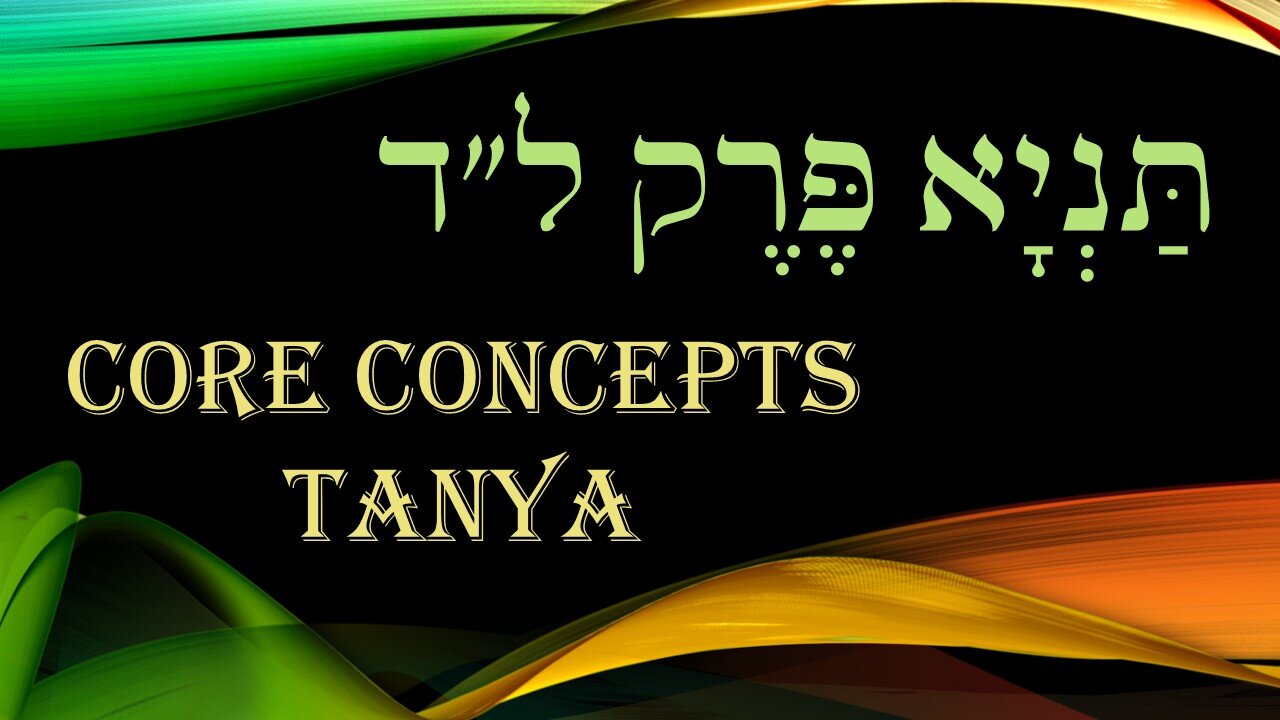Premium Only Content

Core Concepts Tanya: Chapter 34
Brief recap of Chapter 34:
1. Chapter 34 continues and rounds out the ideas begun in Chapter 33 about finding joy in our service of Hashem. That chapter spoke about finding joy through faith in Hashem's unity, in knowing that nothing exists but Him, and fulfilling His will fulfills the purpose of creation in making a home for Hashem in this world.
2. This chapter gets more specific about how we create that home for Hashem. Our forefathers were so given over to Hashem, they were chariots to His will. The same holds true for the great prophets throughout the generations, foremost Moshe Rabeinu, of whom it says the Shechinah spoke from Moshe's throat.
3. The closest the Jewish people ever came to experiencing this sort of union and revelation was at the Giving of the Torah on Har Sinai. However, the Jewish people were not on a level to handle such a revelation, so they immediately expired and Hashem had to resurrect them. As they couldn't live with such revelation in their own selves, Hashem commanded them to build the Mishkan, the Tabernacle, wherein He would dwell and be revealed in greater measure.
4. After the Mishkan came the Bet Hamikdash, and what made these buildings special was that they housed a greater revelation of G-dliness than the rest of the world. When the Bet Hamikdash was destroyed, Hashem was "without a home" wherein to reveal Himself, same as anyone who feels they can be more themselves at home. Where is Hashem's home today? In Torah study. Through learning about Hashem's will and wisdom we make a place where Divine revelation can be at home. Therefore, we make a deal with ourselves that even if we can't be chariots to His will, and even if we can't be Torah scholars day and night, we can set aside time for study at least once in the morning and once at night. This turns our whole day into a Torah day and leads to joy in knowing we've made our own type of dwelling for Hashem in this world.
5. Tzedakah also makes a home for Hashem in this world using, unlike most mitzvot, our whole bodies to fulfill it. When a person works to earn a livelihood, then gives part of the money earned to Tzedakah, it's not only that money which gets elevated, but the entirety of his wealth and every action it took to earn it.
6. We've now learned of three types of joy which help battle sadness over spiritual shortcomings: (1) joy when the soul is released from exile within the body, (2) joy in being close to Hashem through faith in His unity, (3) joy stemming from Hashem's joy in overcoming the sitra achara and negative forces.
7. With all this joy, we must not forget to always work to better ourselves. Moreover, because joy and bitterness leading to action don't come from the same place, they can fully coexist within. Joy stems from the G-dly soul as listed above. Bitterness and sadness stem from the animal soul, and should lead us to always work to make ourselves better. True, Torah and Mitzvot and prayer make a home for Hashem, but we must always work to make that home more and more beautiful through refining ourselves.
-
 1:33:38
1:33:38
Flyover Conservatives
1 day agoAMANDA GRACE | Prophetic Warnings Ignored: What Happens When Leaders Defy God | FOC Show
49.7K16 -
 59:57
59:57
The StoneZONE with Roger Stone
9 hours agoMEDICAL MURDER: A Sneak Peak into the Making of Died Suddenly 2 | The StoneZONE w/ Roger Stone
42.8K10 -
 1:07:03
1:07:03
Tucker Carlson
8 hours agoMother of Likely Murdered OpenAI Whistleblower Reveals All, Calls for Investigation of Sam Altman
137K158 -
 55:44
55:44
LFA TV
15 hours agoCongress Humiliates Itself | TRUMPET DAILY 1.15.25 7pm
129K32 -
 1:42:04
1:42:04
2 MIKES LIVE
10 hours ago2 MIKES LIVE #167 News Breakdown Wednesday!
80.8K15 -
 2:12:19
2:12:19
Quite Frankly
13 hours ago"Fahrenheit 2025: Drone Hysteria, The Fog, Smart L.A." ft. Elana Freeland 1/15/25
89.5K19 -
 1:43:00
1:43:00
Redacted News
11 hours agoBREAKING! CAPITOL POLICE ON HIGH ALERT OVER ATTEMPTS AGAINST TRUMP, MEDIA SILENT | Redacted
196K424 -
 51:09
51:09
Candace Show Podcast
10 hours agoHILARIOUS! TikTok Ban Backfires | Candace Ep 133
151K202 -
 9:42:20
9:42:20
Dr Disrespect
15 hours ago🔴LIVE - DR DISRESPECT - WARZONE - NO MERCY
146K40 -
 2:27:54
2:27:54
Mally_Mouse
8 hours agoLet's Hang!! -- P.O.Box opening! & Stardew Valley pt. 20!
47.7K3